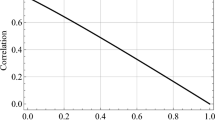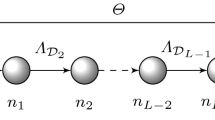Abstract
The McKay density function has been cited in the study of wireless channels in connection with the analysis of diversity. It is also a forerunner of the \(\upeta \)-\(\upmu \) and \(\upeta \)-\(\uplambda \)-\(\upmu \) distributions in wireless channels. Starting with a physical description of fading in terms of clustering and using the existing results from the original work of Nakagami, the probability density function of the signal-to-noise ratio has been shown to match the three parameter McKay distribution. It is demonstrated that the McKay density also allows for the modeling of wireless channels exhibiting fading levels far worse than what is seen in Nakagami channels, allowing the amount of fading to vary from 0 to \(\infty \). The shadowing in wireless channels is then incorporated in the model using the cascading concept to describe the shadowing. The error rates in such a McKay–Meijer G model are studied using the example of a coherent binary shift keying modem. With the availability of closed form expressions for the density, cumulative distribution function, error rates and outage probabilities, the McKay–Meijer G model offers a very flexible means to study the performance of modems in composite shadowed fading channels.








Similar content being viewed by others
References
Simon, M. K., & Alouini, M.-S. (2005). Digital communication over fading channels: A unified approach to performance analysis (2nd ed.). Hoboken, NJ: Wiley.
Shankar, P. M. (2012). Fading and shadowing in wireless systems. New York: Springer.
Nakagami, M. (1960). The \(m\)-distribution—A general formula of intensity distribution of rapid fading. In W. C. Hoffman (Ed.), Statistical methods in radio wave propagation. Elmsford, NY: Pergamon.
Yacoub, M. D. (2007). The alpha-mu distribution: A physical fading model for the Stacy distribution. IEEE Transactions on Vehicular Technology, 56, 27–34.
Yacoub, M. D. (2007). The \(\kappa \text{- }\mu \) and \(\eta \text{- }\mu \) distribution. IEEE Antennas and Propagation Magazine, 49, 68–81.
Radaydeh, R. M., & Matalgah, M. M. (2008). Compact formulas for the average error performance of noncoherent m-ary orthogonal signals over generalized Rician, Nakagami-m, and Nakagami-q fading channels with diversity reception. IEEE Transactions on Communications, 56, 32–38.
Papazafeiropoulos, A. K., & Kotsopoulos, S. A. (2011). The \(\alpha \) -\(\lambda \)- \(\mu \) and \(\alpha \) - \(\eta \)- \(\mu \) small-scale general fading distributions: A unified approach. WIRE, 57, 735–751.
McKay, A. T. (1932). A Bessel distribution function. Biometrika, 24, 39–44.
Holm, H. (2002). Adaptive coded modulation performance and channel estimation tools for flat fading channels. Ph. D. Thesis, Department of Telecommunications, Norwegian University of Science and Technology.
Holm, H., & Alouini, M.-S. (2004). Sum and difference of two squared correlated Nakagami variates in connection with the McKay distribution. IEEE Transactions on Communications, 52, 1367–1376.
Shankar, P. M. (2012). A Nakagami-N-gamma model for shadowed fading channels. WIRE, 64, 665–680.
Andersen, J. B. (2002). Statistical distributions in mobile communications using multiple scattering. In Proc. Gen. Assem. Int. Union of Radio Sci. Maastricht, The Netherlands.
Asplund, H., Molisch, A. F., Steinbauer, M., & Mehta, N. B. (2002). Clustering of scatterers in mobile radio channels—Evaluation and modeling in the COST259 directional channel model. In Proc. IEEE ICC, New York (pp. 901–905).
Papoulis, A., & Pillai, S. U. (2002). Probability, random variables and stochastic processes (4th ed.). New York: McGraw-Hill.
Gradshteyn, I. S., & Ryzhik, I. M. (2000). Table of integrals, series, and products (6th ed.). New York: Academic.
Nadarajah, S., & Kotz, S. (2006). Bivariate gamma distributions, sums and ratios. Bulletin of the Brazilian Mathematical Society New Series, 37, 241–274.
Okui, S., Morinaga, N., & Namekawa, T. (1981). Probability distributions of ratio of fading signal envelopes and their generalizations. Electronics and Communications in Japan, 64–B, 1228–1235.
Di Salvo, F. (2008). A characterization of the distribution of a weighted sum of gamma variables through multiple hypergeometric functions. Integral Transforms & Special Function, 19, 563–575.
Karagiannidis, G. K., Sagias, N. C., & Tsiftsis, T. A. (2006). Closed-form statistics for the sum of squared Nakagami-m variates and its applications. IEEE Transactions on Communications, 54, 1353–1359.
Yilmaz, F., & Alouini, M.-S. (2012). A novel unified expression for the capacity and bit error probability of wireless communication systems over generalized fading channels. IEEE Transactions on Communications, 60, 1862–1876.
Wojnar, A. H. (1986). Unknown bounds on performance in Nakagami channels. IEEE Transactions on Communications, 34, 22–24.
Author information
Authors and Affiliations
Corresponding author
Rights and permissions
About this article
Cite this article
Shankar, P.M. A Composite Shadowed Fading Model Based on the McKay Distribution and Meijer G Functions. Wireless Pers Commun 81, 1017–1030 (2015). https://doi.org/10.1007/s11277-014-2168-2
Published:
Issue Date:
DOI: https://doi.org/10.1007/s11277-014-2168-2




